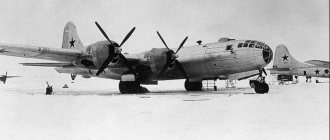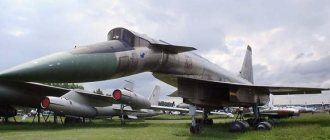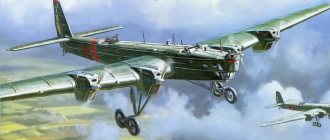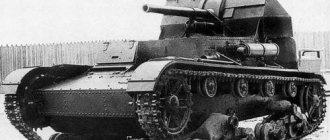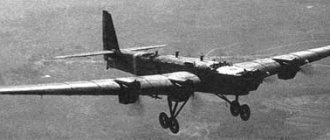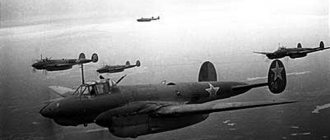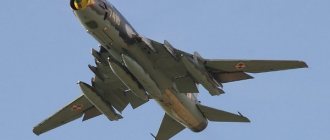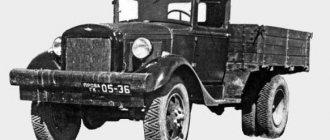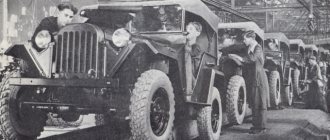The Su-34 is a bomber aircraft that was designed by the Sukhoi design bureau. The development of this device began in the 80s of the last century. Experienced R.G. was appointed chief designer of the project. Martirosov, but it should also be noted the designer M.P. Simonov, who made considerable efforts to create this aircraft.
As for the Su-34 aircraft project, the design bureau designated this aircraft as the T-10B. The basis of this device was intended to be based on the Su-27UB aircraft. According to the initial project, it was planned to modernize a large number of systems of the Su-27 type aircraft, which would ultimately lead to the emergence of a new modification.
A brief history of the appearance and testing of the Su-34 aircraft
The design of a new vehicle called the Su-34 was completed in early 1990. After the development was completed, the production of a prototype began. The new machine was created by converting the Su-27UB training aircraft. It was equipped with all the equipment and parts of the structure that the designers had thought of. This work was carried out at the Sukhoi aircraft plant, workers replaced the nose, engine nacelles and air intakes.
The converted aircraft first flew in the spring of 1991. The Su-39 fighter-bomber was fully ready in the winter of 1993. A year later, this machine was presented to the public in Paris at an air exhibition. The plans of the manufacturers clearly show the idea of selling it on world markets, since at international exhibitions it has an English abbreviation. Some vehicles are painted in nautical colors, which allows them to be used over water areas and placed on aircraft carriers.
History of creation
The Su-34 fighter-bomber (NATO code Fullback) with an expanded functional purpose was created as a successor to the well-known Su-24 bomber and attack aircraft. When creating a new vehicle, the factor of the potential enemy’s use of fourth and transitional to fifth generation fighters was taken into account.
Initially, the design was developed according to the “longitudinal triplane” design, which was well studied at the Sukhoi Design Bureau. At the same time, the dimensions of the aircraft, compared to its predecessor Su-24, were increased, which made it possible to increase the range and combat load.
A new feature was the flattened shape of the nose cone, which made it possible to implement a cabin layout with a parallel arrangement of two crew members.
Due to the characteristic shape of the front part of the fuselage, the Su-34 aircraft received the nickname “Duck” or, more commonly, “Duckling”.
This layout was borrowed from an unfinished project of a training aircraft for training pilots of shipborne carrier-based aviation.
Development of the project under the code T-10B began in the summer of 1986 under the leadership of the general designer of the design bureau M.P. Simonov, and already in the spring of 1990 the first flight of a prototype of a promising machine was carried out. To build the prototype, a production copy of the Su-27UB aircraft was used.
Further development slowed down due to the collapse of the USSR and the crisis situation in the Russian Federation. The general public saw “Duck” at the end of winter 1992 at an exhibition in Belarus.
The aircraft was then demonstrated at annual exhibitions in 1992 and 1993 in Zhukovsky. The first international display of the Su-34 took place at the Le Bourget air show in the late spring of 1995.
Subsequent static and flight tests of the aircraft took another 9 years, during which six pre-production aircraft were used. State tests of the Su-34 began 20 years after the start of design work and lasted almost five years.
At the same time, production of single serial vehicles was underway, which took part in the conflict in South Ossetia. The official adoption of the Su-34 fighter-bomber into service with the Russian Air Force took place only in March 2014.
Currently, there is a systematic increase in production volumes of the aircraft, which should completely displace the Su-24 from combat units by 2022.
As of fall 2022, at least 108 copies of the bomber have been produced and shipped. Based on the main model of the Su-34 aircraft, there is only one modification - the Su-32, intended for export.
Features of the Su-34
When designing the Su-39, all the experience of aircraft design at the Sukhoi Design Bureau was taken into account, which made it possible to achieve such high results. The cockpit is made as a monolithic armored capsule. In addition to the cabin, all vital systems and assemblies are equipped with armor, which increases the survivability of the vehicle. The entire armor of the aircraft weighs almost 1.5 tons. To increase survivability, the aircraft is equipped with active protection systems, which are the same as those in the Su-27 aircraft.
To more effectively carry out combat missions, all processes are carried out by the pilot and his assistant navigator. The cockpit is quite comfortable and spacious, you can even stand upright in it. In addition, the plane is equipped with a toilet and a special cabinet for heating food. The cockpit is capable of maintaining a normal microclimate, which allows flights at an altitude of 10 kilometers without the use of oxygen masks. All these systems contribute to better performance of the aircraft’s pilots even during long flights, which can reach 10 hours.
The Su-34 aircraft was created to destroy both ground and water targets of the enemy. In addition, it is capable of hitting moving targets even of small size. As for air targets, the aircraft has the ability to destroy air targets at any time of the day or night under any meteorological conditions.
The development and improvement program for the Su-34 aircraft is the most promising, since the aircraft has excellent flight and tactical characteristics.
Design features of the Su-34 bomber
This machine is designed as a longitudinal triplane, which has an integral layout. The wings of the device are connected to the body of the machine using an integrated circuit. They have a trapezoidal shape, and their leading edge is arrow-shaped. The tail section of the aircraft is almost the same as in the previous version.
The cabin has seats for the pilot and navigator, it is completely sealed and armored. The cabin is heated and air conditioned. For better interaction between pilots, their seats are located nearby. The pilot's seat is on the left, and the navigator sits on the right side of the board. To get into the cockpit, pilots climb through a niche for the front landing gear along a special folding ladder.
The aircraft's landing gear is made of a trolley type, and the wheels are arranged in tandem, which improves the quality of takeoff from airfields that are poorly prepared. The front landing gear is steerable and equipped with two wheels. All landing gear struts are retracted into niches during flight. The rear pillars of the car are equipped with brake systems.
The aircraft's power plant consists of two turbojet engines, which are equipped with two afterburners. AL-31 type engines, which are installed on the Su-34 aircraft, develop power up to 14,000 kgf.
The fuel system in this aircraft is represented by three tanks in the middle of the fuselage: one in the middle of the center section, and two more tanks are located in the wing consoles. The fuel pumps in the fuel system supply fuel to the engines, regardless of the vehicle's position in the air. On hauls, you can install additional drop tanks, which, if necessary, can be dropped during the flight. As for the fuel system and the length of the flights, it should be noted that the aircraft is equipped with an in-flight refueling system. Refueling can be carried out from similar aircraft such as Su-34 or from tankers such as Il-78.
The aircraft is equipped with the latest integrated navigation system, which allows you to maintain communication with the satellite. For easier control, the machine has a multi-channel CDS system. It is capable of independently analyzing overloads and angles of attack, and also controls the PGO and at the same time effectively dampens all vibrations. The safety system is so good that it can automatically prevent collisions with other objects or the ground.
To solve all combat missions, the aircraft is equipped with the latest generation avionics system; it is almost completely automatic. All information systems located on board are arranged in an autonomous version.
Interesting facts and cases from operation
Fact of non-combat use of Su 34 . On April 18, 2016, a pair of Su 34 bombed an ice jam on the Northern Dvina. Going in to bomb one at a time, they dropped about 4 tons of bombs in two passes in the area of the Kobylinsky rifts, hitting exactly the right place.
In June 1995, before flying to the aviation show in France, they decided to show the new aircraft to the general designer of the Su 34 , M.P. Simonov. After the fourth turn, the main landing gear did not come out, the crew, understanding the situation, made a turn with a large roll and literally pushed out the main struts, after which the car was safely landed on a concrete strip. One can understand the feeling of the general designer, because they saved not only the new prototype aircraft, but also did not disrupt its display at the French aviation show.
On August 3 of the same year, test pilot V. Petrusha and navigator V. Oshchepkov, having loaded five tons of bombs and missiles, rose to a height of 15050 m, thereby setting a new world record, simultaneously lifting 5129 kg of payload by 2000 m and exceeding another achievement .
In the same month, on the 19th, three more world achievements were exceeded at MAKS-99, test pilot I. Solovyov and test navigator V. Shendrik for an aircraft with a take-off weight of up to 45 tons reached an altitude of 16,150 meters with a payload of 2.3 tons, which a jet aircraft of this class has never achieved before.
Su 34
Another sad fact, while landing at the Buturlinovka airfield, the Su 34 on June 4, 2015 rolled out of the runway and overturned, the crew members remained safe and sound.
As of February 23, 2016, the Russian Aerospace Forces of Russia have 83 Su 34 , the production of which has been established at NAPO. V. Chkalova (Novosibirsk), 6 thousand workers and engineers were involved in the assembly.
Air strike by Su-34 bombers during the Center-2015 exercise
Su-34 characteristics:
| Modification | Su-34 |
| Wingspan, m | 14.70 |
| Aircraft length, m | 22.00 |
| Aircraft height | 5.93 |
| Take-off weight, kg | |
| normal | 39000 |
| maximum | 44360 |
| engine's type | 2 TRDF AL-35 (AL-31F) |
| Unforced thrust, kgf | 2 x 14000 |
| Maximum speed, km/h | |
| at an altitude of 11000 m | 1900 (M=1.6) |
| at sea level | 1400 |
| Practical range, km | 4500 |
| Combat radius, km | 600 -1130 |
| Practical ceiling, m | 17000 |
| Max. operational overload | 7 |
| Crew, people | 2 |
| Weapons: | one 30 mm GSh-301 cannon (180 rounds) |
| Combat load - 8000 kg (normal - 4000 kg) on 12 hardpoints: | |
| 8 air-to-air missiles R-73; | |
| 6 air-to-air missiles R-27RE or E; | |
| 8 air-to-air missiles R-77 (RVV-AE); | |
| 6 air-to-surface missiles X-29T/L, X-25ML, S-25LD | |
| 6 air-to-radar missiles X-31P or air-to-ship X-31A; | |
| 1 multi-purpose missile launcher Alpha; | |
| 3 X-59M air-to-surface missiles; | |
| 3 adjustable aerial bombs KAB-1500L/TK; | |
| 6 adjustable aerial bombs KAB-500KR/L; | |
| 3 bombs of 1500 kg caliber, 16 bombs of 500 kg caliber, 36 bombs of 250 kg caliber, 48 bombs of 100 kg caliber, 8 KMGU containers, 120 S-8 missiles (in 6 B-8M1 blocks), 30 S-13 missiles (in 6 B-13L blocks) or 6 S-25 missiles. |
USSR combat aircraft
